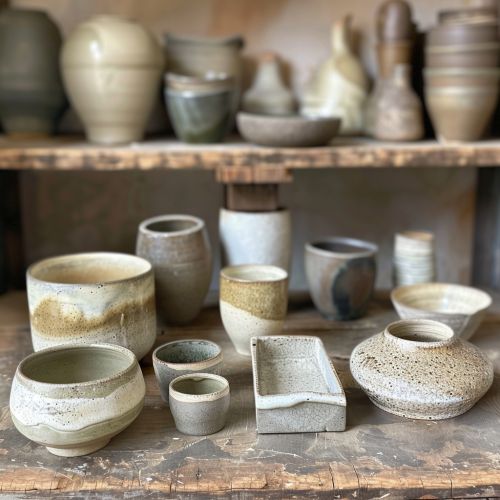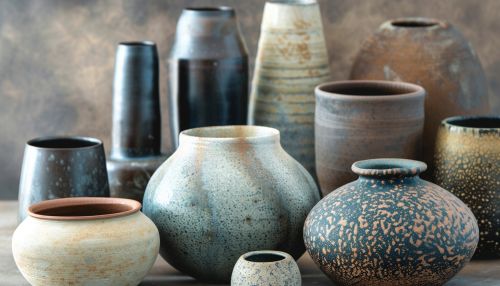Stoneware
Definition and Origin
Stoneware is a type of pottery that has been fired to a high temperature (about 1,200°C to 1,315 °C) and is very strong and durable. It is known for its dense, impermeable and hard qualities. The clay used to make stoneware is usually naturally grey or brownClay Types. Stoneware, named after its stone-like qualities, can be left unglazed, but often it is glazed for decoration, or to make the vessel more impermeable.
The origin of stoneware dates back to the Neolithic Age, where it was discovered in China. The earliest forms of stoneware were made around 1400 BC, and by the Shang Dynasty, the production of stoneware had become more refined and sophisticated.


Production Process
The production process of stoneware involves several steps. First, the clay is prepared by removing impurities and adding water to achieve the right consistency. The clay is then shaped into the desired form using various methods such as hand-building, wheel throwing, or molding. After shaping, the piece is left to dry, a process that can take several days to weeks depending on the size and thickness of the piece.
Once the piece is completely dry, it is fired in a kiln at a high temperature. This process, known as bisque firing, transforms the clay into a hard, stone-like material. After the bisque firing, the piece is often glazed and then fired again in a process known as glaze firing. The glaze serves both a decorative and functional purpose, adding color and design to the piece and making it more impermeable.
Types of Stoneware
There are several types of stoneware, each with its own unique characteristics and uses. These include:
1. Earthenware Stoneware: This is the most common type of stoneware and is typically used for everyday household items such as dishes and bowls. It is fired at lower temperatures and is less durable than other types of stoneware.
2. Porcelain Stoneware: This type of stoneware is fired at very high temperatures, making it extremely durable and resistant to chipping and cracking. It is often used for fine china and other high-quality ceramics.
3. Bone China Stoneware: This is a type of porcelain stoneware that includes bone ash in its composition. It is known for its high strength and chip resistance, and its delicate, translucent appearance.
4. Ironstone Stoneware: This is a type of stoneware that was developed in the 19th century to be as strong and durable as iron. It is often used for heavy-duty items such as cookware and bakeware.
Uses of Stoneware
Stoneware has a wide range of uses due to its durability and versatility. It is commonly used in the production of tableware such as plates, bowls, mugs, and serving dishes. It is also used to make cookware such as baking dishes and casserole dishes, as it can withstand high temperatures and is safe to use in the oven, microwave, and dishwasher.
In addition to its culinary uses, stoneware is also used in the production of decorative items such as vases, planters, and figurines. Its ability to hold intricate detail makes it a popular choice for artists and sculptors.
Stoneware vs Other Ceramics
Stoneware is often compared to other types of ceramics such as earthenware and porcelain. While all three types are made from clay and fired in a kiln, there are key differences in their composition, firing temperatures, and final properties.
Earthenware is fired at lower temperatures than stoneware and is therefore less durable and more porous. It is often glazed to make it more waterproof. Porcelain, on the other hand, is fired at higher temperatures than stoneware, resulting in a more durable and less porous material. It is also typically whiter and more translucent than stoneware.
Care and Maintenance
Stoneware is known for its durability, but like all ceramics, it can be damaged if not properly cared for. It is generally safe to use in the dishwasher, microwave, and oven, but sudden temperature changes can cause it to crack. Therefore, it is recommended to avoid moving stoneware directly from a hot oven to a cold surface, or vice versa.
When cleaning stoneware, avoid using abrasive cleaners or scrubbing pads, as these can scratch the surface. Instead, use a soft cloth or sponge and mild detergent. If food becomes stuck on the surface, soaking the piece in warm water can help loosen it.
